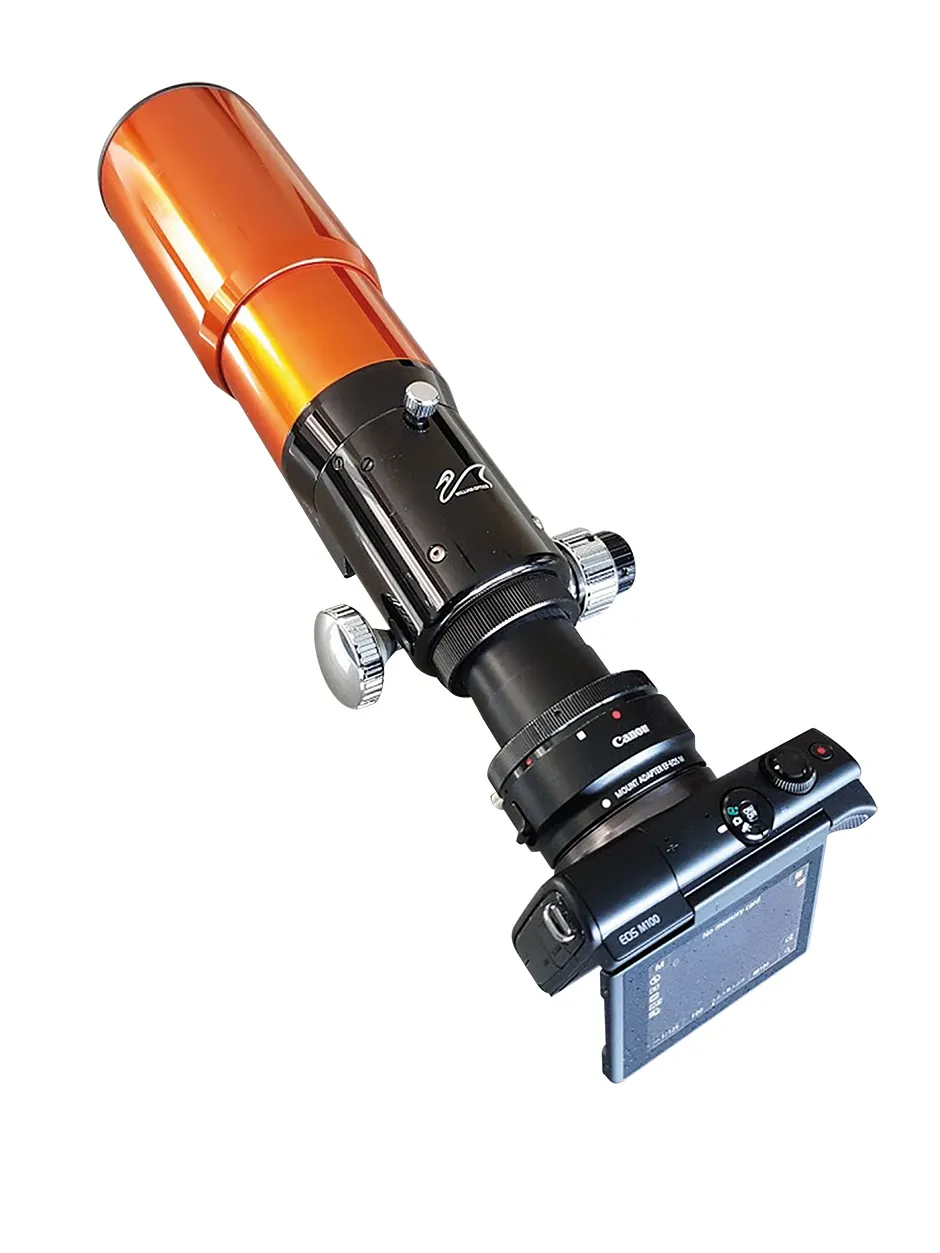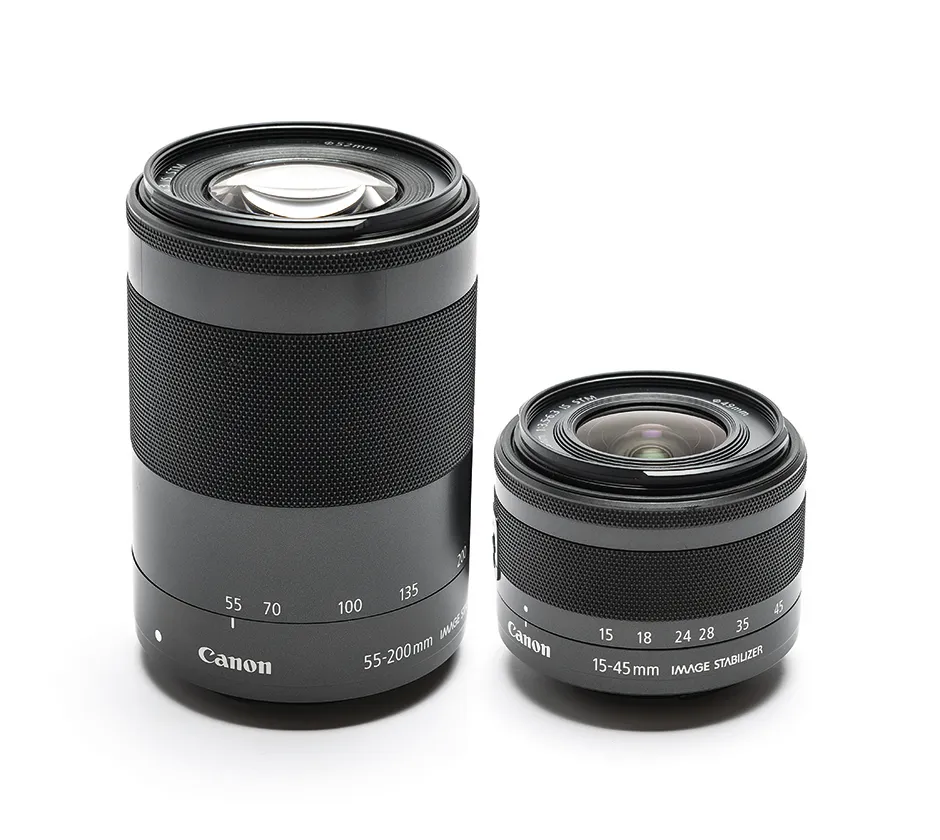The EOS M100 is an entry-level, mirrorless, interchangeable lens camera (MILC) from Canon that provides through-the-lens subject monitoring directly via the sensor.It looks like a stripped-down DSLR, but has neither a flip mirror nor viewfinder optics, resulting in a more compact, lighter and easier-to-carry camera body.
The lack of a flip mirror also eliminates possible camera shake at the start of a long exposure when the mirror moves out of the way.
Canon’s M-series cameras are designed to use EF-M lenses, which are smaller and lighter than conventional Canon EF/EF-S lenses.But you can still use EF/EF-S lenses on the EOS M100 with the help of an optional, albeit pricey, adaptor.
The adaptor also allows you to connect the EOS M100 to a telescope via an EF-T mount adaptor.You select the shooting mode using a menu system and can choose between aperture priority, shutter priority, programmable or manual modes.
You can set the shutter speed to take exposures lasting anywhere between 1/4,000th of a second to 30 seconds, or even longer with the use of the bulb mode.
ISO settings extend from 100-25,600, but we achieved excellent night-time results with mid-range values of 1,600-3,200.
The rear display serves as a touchscreen interface for control settings and image review.
The display flips up by 180° around a top hinge, which is not only helpful for taking selfies but, more crucially, provides easier access to the screen with awkward telescope configurations.
Sadly, there’s no red-light option to preserve your eyes’ dark adaptation.
This camera is on our list of the best cameras for astrophotography.
Control issues

One of our biggest issues with the EOS M100 is the lack of a direct connection port to control it remotely.Only USB and HDMI connections are provided.
And as with other Canon’s M-series cameras, the EOS M100 does not currently support tethered control via applications such as BackyardEOS.
However, remote operation can be achieved to a degree by connecting the camera via Wi-Fi, Bluetooth or near-field connection.
We used the Canon Camera Connect app on a Samsung Galaxy S7 smartphone (Android) and were able to frame and review images as well as remotely control the EOS M100.
This app allows you to extend exposures beyond 30 seconds in conjunction with the EOS M100’s bulb mode, but there’s no intervalometer function.
One of our test targets was the Sword of Orion region, a familiar subject in the winter months.We started by capturing Orion rising using the 15-45mm and 55-200mm EF-M lenses that came with the camera.
The results were encouraging, with similar detail to what we would expect with a regular Canon DSLR.
A simple 15-second exposure of the constellation’s belt-and-sword region showed lots of detail, many faint stars and acceptable noise at mid ISO levels.
Working with a telescope

Our experience using the EOS M100 with a telescope was similarly encouraging.A 30-second exposure at ISO 1600 over-exposed M42’s core, as expected, but the surrounding area showed fine details, especially in the swept-back regions either side of the core.
The faint ring of nebulosity, which extends in a southerly direction from the main nebula, was also captured, as was the stick figure silhouette in the Running Man Nebula, NGC 1977.
In conclusion, the EOS M100 is a great camera for ultra-portable astrophotography but it’s not perfect.Like any general-purpose camera, the main sensor is fitted with an infrared filter which interferes with the camera’s h-alpha response causing colour balance issues with h-alpha rich targets.
The lack of both a physical connection for an intervalometer and a red screen option are issues too.And the battery life is nothing to write home about: 295 shots, or 410 shots in eco mode, under normal daytime temperature conditions.
Best keep some charged spares handy.
Portable imaging

As an astrophotographic travelling companion, the EOS M100 is certainly flexible, easy to use and highly portable.Whether coupled to a standard lens or to a telescope, the EOS M100 is capable of taking some great astronomy shots.
It outputs images in the Canon RAW file format and also HD video (1,920x1,080).Despite lacking the bulk and weight of a traditional DSLR camera, the EOS M100 still manages to emulate much of their functionality.
With a compact body measuring a mere 108.2x67.1x35.1mm and weighing in at just 302g, the EOS M100 is a fantastic camera for travelling and ideal for coupling to a small refracting telescope.
All of which makes it perfect for taking on location for deep sky photography sessions.The M-series EF-M lenses are also compact, lightweight and easy to carry.
A remote shutter release is important for many astrophotographic sessions and as long as you have charge in a Wi-Fi, Bluetooth or near-field connection-enabled device, it’s possible to use them for remote operation.
One key omission is the lack of a physical connection for an intervalometer.
EF-M compact lenses
The EOS M100’s small profile is reflected in the design of the EF-M lenses, which the camera has been tailored to use.The lenses are smaller than the EF/EF-S lenses normally used with DSLR cameras.The camera is supplied with EF-M 15-45mm and 55-200mm lenses, giving good coverage for wide- and medium-field photography.EF/EF-S lenses/T-rings can be attached using an optional EF-EOS M adapter, which costs £104.99.
Clear controls
Unlike a traditional DSLR, the EOS M100’s body is uncluttered with relatively few control buttons.One of the bugbears for astrophotography is trying to work out which unlit button to press in the dark, so the lack of confusion here is welcome.Instead, many of the commonly used settings, such as camera mode, are available through the camera’s touchscreen menu system.
Bluetooth & Wi-Fi control
The M100 offers remote control via Wi-Fi, Bluetooth or a near-field connection link.The Wi-Fi link allows the camera to connect with devices such as smartphones and tablets, with remote control being established via apps such as Canon Camera Connect.
Sensor
The sensor at the heart of the EOS M100 is an APS-C format, 24.2 megapixel CMOS device.This is the same sensor used in the Canon EOS 80D DSLR. It consists of a 6,000x4,000 array of 3.7 micron pixels producing an imaging area that measures 22.3 x 14.9mm.
Articulated screen
Camera control, image composition and review are carried out using a 75mm, 180° articulated touchscreen.This high-resolution, 1,040,000 pixel screen has five levels of brightness and displays approximately 100 per cent of what the camera ‘sees’ through the lens.The screen’s 3:2 aspect ratio mirrors the sensor’s 6,000x4,000 pixel array.
Vital stats
- Price: £449.00
- Weight: 302g
- Supplier: Canon UK
- Telephone: 01582 726522
- Website:www.canon.co.uk
This review originally appeared in the April 2018 issue of BBC Sky at Night Magazine
